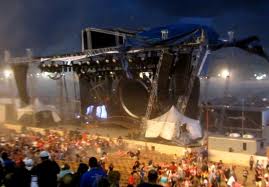There are many things which could go wrong at an event, some of these can be small incidents such as a band not turning up and others can damage property and potentially be life threatening. Tutor2u.net (2012) identifies contingency planning as the strategic approach of identifying what could go wrong during an event and how it can be dealt with to minimise it affects. Leoisaac.com (n.d.) builds upon this by indicating that contingency plans are just important for minimising damage but also retain the events reputation as well as the organisers.
So, putting all this into consideration, when you attend an event you should feel that if anything does go wrong there are adequate measure to stop you from getting hurt. However this is not the case! Just take The Indiana State Fair in 2011 when the stage collapsed due to strong winds. When this stage came crashing down it didn’t just end the festival but sadly ended the lives of five fans eagerly waiting the start of the show. Even though the state police said there was nothing that could have been done to prevent it, Rocknewsdesk.com (2011) suggests that there was a lack of understanding of who had the authority to cancel the event. There were even suggestions that the weather reports were badly communicated which resulted in the organiser’s poor decision to carry on the event. Overall it can be said that this event didn’t have proper contingency plans in place for bad weather as the organisers were indecisive in their decisions.
However an example of when a contingency planning was successfully implemented was when I attended Benicassim 2009. On the night when Oasis was playing the winds picked up and various temporary demountable structures started compromising their safety. The management team at Benicassim acted quickly and it was clear they had an evacuation plan implemented as we were all moved to the local sports hall to ensure nobody was hurt. Americanprinter.com (1997) would indicate that this was a very professional event operation supported by a well thought out contingency plan.
Americanprinter.com (1997) proposes that there are five steps which should be undertaken when planning contingency plans. Firstly a dedicated group should be implemented to consider all the various scenarios which could go wrong with the event. Thirdly, once the list has been created, it should be examined to see if there are any internal plans which could be put in place to prevent disasters. After identifying the internal plans it is important to set up external strategies whilst gaining insurance. Finally, Americanprinter.com (1997) empathises that keeping plans up to date is crucial as new obstacles arise all the time, hence the importance of setting up a dedicated group to take control of contingency planning.
This blog has highlighted examples of good and poor contingency planning. As was shown at the Indiana State Fair it is crucial to abide by Americanprinter.com (1997) to ensure that when something does go wrong you can act quickly in prevention of customers getting hurt.
Americanprinter.com (1997) Forming a contingency plan.. [online] Available at: http://americanprinter.com/alt/mag/printing_forming_contingency_plan/ [Accessed: 14 Dec 2012].
Leoisaac.com (n.d.) Event Management: Contingencies in Event Management. [online] Available at: http://www.leoisaac.com/evt/top091.htm [Accessed: 14 Dec 2012].
Rocknewsdesk.com (2011) Five die in stage collapse | Rock News Desk. [online] Available at: http://rocknewsdesk.com/world-news/four-die-in-stage-collapse/2992/ [Accessed: 14 Dec 2012].
Tutor2u.net (2012) Managing Risk – Contingency Planning. [online] Available at: http://www.tutor2u.net/business/strategy/risk_contingency_planning.html [Accessed: 14 Dec 2012].




 British Standards (BS) produced a policy known as BS 8901 with its main aim to guide the events industry on how to operate in a sustainable manner. However he also identifies that Britain were not the only country developing these standards, each country had their own variation. This lead to the International Standards Organisation (ISO) emerging with a new concept linking everyone’s policies together in order to have a common standard, known as ISO 20121 and was heavily influenced by BS 8901 and showcased by the London Olympics. Bsigroup.com (2012) identify that this policy brings together a variety of different countries ideas in order to have a common standard which will be made more efficient and in the long term by cutting costs via better energy and waste management. Iso20121.org (2012) detects that the standards aim is to tackle environmental, economic and social sustainability by producing a management system that an organisation has to have in place in order to achieve the decorated status of ISO 20121.
British Standards (BS) produced a policy known as BS 8901 with its main aim to guide the events industry on how to operate in a sustainable manner. However he also identifies that Britain were not the only country developing these standards, each country had their own variation. This lead to the International Standards Organisation (ISO) emerging with a new concept linking everyone’s policies together in order to have a common standard, known as ISO 20121 and was heavily influenced by BS 8901 and showcased by the London Olympics. Bsigroup.com (2012) identify that this policy brings together a variety of different countries ideas in order to have a common standard which will be made more efficient and in the long term by cutting costs via better energy and waste management. Iso20121.org (2012) detects that the standards aim is to tackle environmental, economic and social sustainability by producing a management system that an organisation has to have in place in order to achieve the decorated status of ISO 20121.
![Google.co.uk (1977) Google Image Result for http://www.carvinmuseum.com/images/yearbyyear/1977/77_stage9-small.jpg. [online] Available at: http://www.google.co.uk/imgres?um=1&hl=en&newwindow=1&tbo=d&tbm=isch&tbnid=6wrDqcwhhZRgFM:&imgrefurl=http://www.carvinmuseum.com/decade/77-proaudio.html&docid=aobgsjE5KZWTmM&imgurl=http://www.carvinmuseum.com/images/yearbyyear/1977/77_stage9-small.jpg&w=500&h=307&ei=127KULHREZDs0gWQ5YG4Cw&zoom=1&iact=rc&dur=12&sig=115530870067275045910&page=1&tbnh=131&tbnw=210&start=0&ndsp=27&ved=1t:429,r:4,s:0,i:100&tx=129&ty=9&biw=1366&bih=624 [Accessed: 14 Dec 2012].](https://stuforth.wordpress.com/wp-content/uploads/2012/12/speakers.jpg?w=240&h=147)